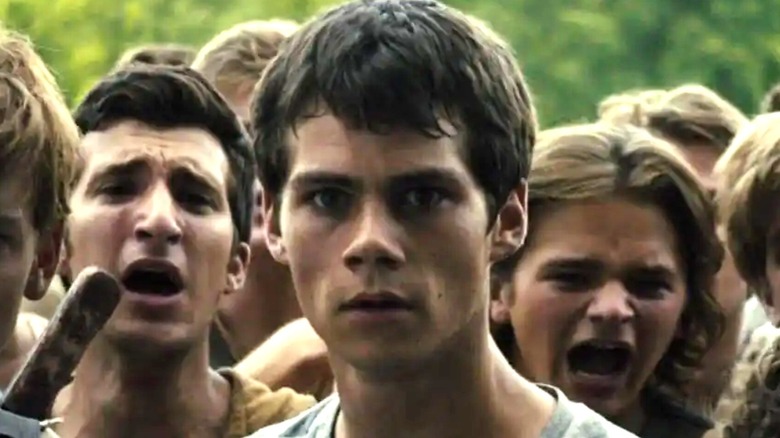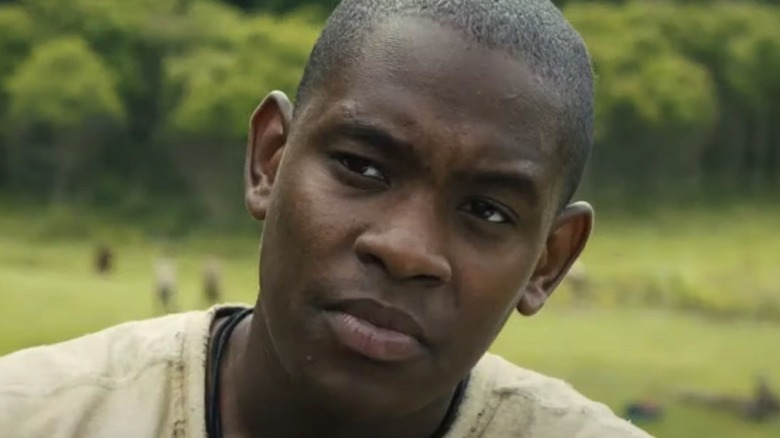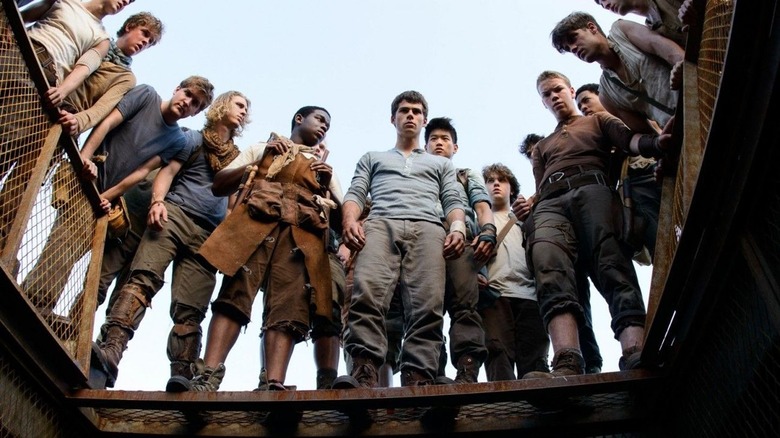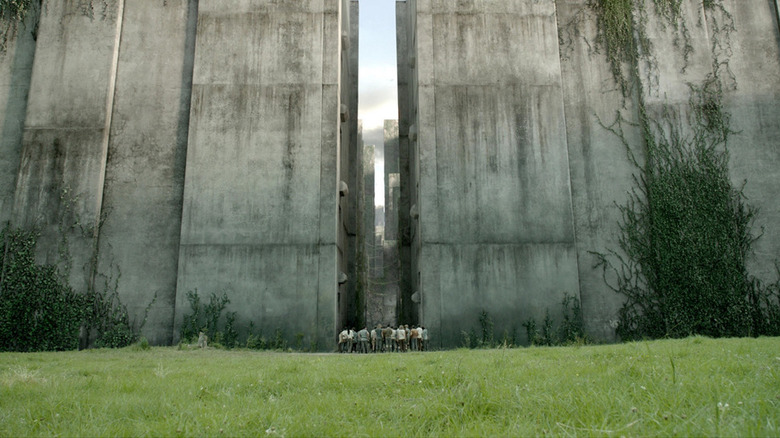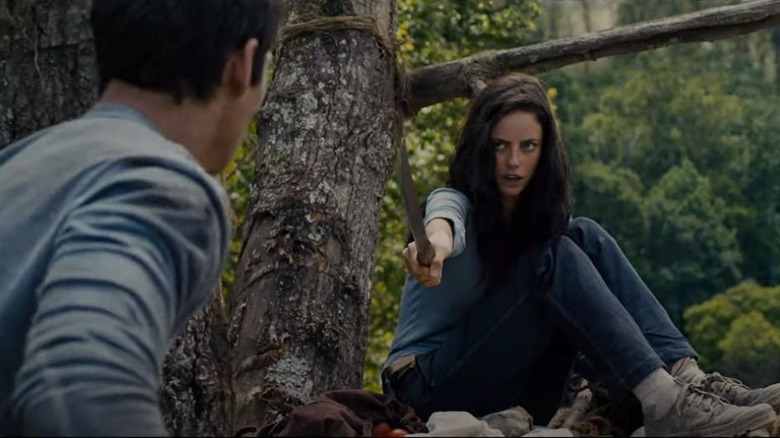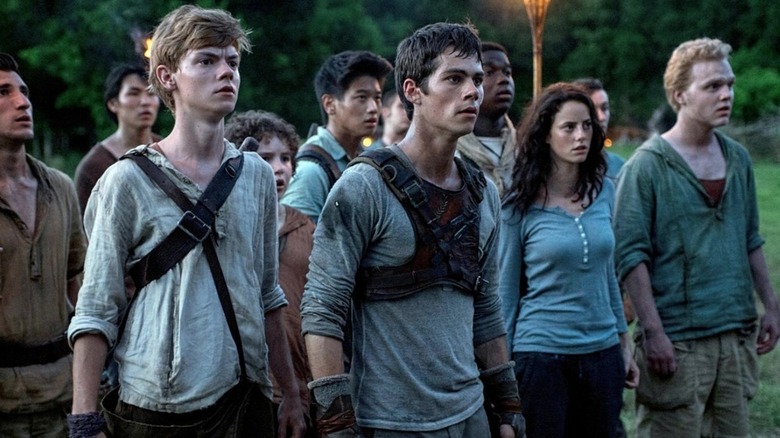Things Only Adults Notice During The Glade Scenes In The Maze Runner
2014's "The Maze Runner" is an intriguing dystopic sci-fi mystery. Thomas (Dylan O'Brien) arrives in a mysterious place surrounded by gigantic walls, and populated by a group of boys who have been there long enough to develop a tribe-like social structure of their own. This, of course, is just the start of the story, and the situation soon escalates to outright impossible proportions when the group finds out the full extent of their peril.
The literal and figurative center of the movie is the Glade, the mysterious green space that the characters reside in and try to escape. Unfortunately, said escape proves to be very difficult, since the Glade is in the middle of a labyrinth populated by lethal monsters known as Grievers. As such, there are many scenes that take place in this lush location, and if you pay attention, you can notice all sorts of things that might go over a younger viewer's head.
Alby had to figure things out all by himself
"The Maze Runner" begins near the tail end of the WCKD experiment, when the last people arrive in the Glade and its safety is breached. However, it neglects to show the equally interesting story of the first poor kid who finds himself in this dystopic situation — Alby (Aml Ameen), the leader of the Gladers.
Though their situation is far from optimal, late arrivals like Thomas at least have a group of Gladers already waiting for them, ready to explain the rules of their predicament. However, the movie establishes early on that Alby was the first person to enter the Glade. This means he had to face it all alone before other people started trickling in ... and since it's mentioned that new arrivals come on a monthly basis, he presumably had to do it for a pretty long time.
For an entire month, Alby had to survive without any real pre-existing information of the situation he found himself in. Imagine the terror of a young man who finds himself alone in this mysterious place, completely devoid of memories. Imagine how he stared at the giant walls around him, and discovered the vast, monster-filled labyrinth beyond them. Imagine how he managed to survive said discovery, and how terrified he must have been before he figured out that the Grievers won't enter the Glade area.
That story alone would be a movie well worth seeing ... though, to be fair, it would almost certainly be a horror movie.
The social structure of the Glade is fairly realistic
William Golding's "Lord of the Flies" and its various adaptations may be the best-known tale of stranded boys and their attempts to work together, but while that story portrays the group's descent into violent mayhem, the Glade's fairly civilized and organized structure is a far more accurate portrayal of a real-life version of a marooned group of youngsters.
In 1965, a group of six boys actually ended up stranded on a small, unpopulated island in the Pacific, and promptly started working together to survive (per The Guardian). These kids survived on the island for 15 months, and by the time they were found and rescued, they had managed to build a surprisingly comfortable life, as well as amenities that included a garden, water-gathering systems, and a gym. They also kept a signal fire burning for over a year, attempted to escape their predicament in numerous ways, and even managed to successfully treat an injured kid.
From working together and building surprisingly complex accommodations to actively looking for ways to escape the maze, the Glade's denizens deal with their situation in a very similar manner — they even have a version of the "gym and fire" thing with their recreational wrestling matches and bonfires. Sure, the group is much larger, so there are some disagreements and methods for punishment. Yet, on the whole, the Gladers seem to have their things together in a pretty believable way, which is a welcome dose of realism in the outlandish plot.
The Glade is riddled with home symbolism
Though the Glade is very much a prison, it also serves the function of a home base in "The Maze Runner." As such, the movie includes plenty of home-themed symbolism to back up the point.
The characters arrive in the Glade nameless and without memories, and eventually take their place in its social structure, much as they'd grow up and find their place in a more ordinary society. The Glade is where they live their lives, sleep, eat, and shelter. What's more, their "home" keeps them safe from the dangers outside, and later in the movie, there's even a "home invasion" when the gates open and the Grievers attack the Glade.
As Slashfilm reported from the set of the movie in 2014, the home community vibe of the Glade is further reinforced by the fact that the cast put in the work to build the necessary camaraderie. Apart from a survival boot camp they took together, they spent a night in the Glade just before the filming started ... during a massive thunderstorm, no less.
The lack of female Gladers is not a great look
Mere moments into "The Maze Runner," you immediately realize that the Glade's gender distribution is severely imbalanced. In fact, Teresa (Kaya Scodelario) is the sole female Glader, and the last one of them to arrive.
In the source material, this is somewhat explained by the fact that WCKD (or WICKED, as the organization rather suspiciously calls itself in the novel) actually constructed two labyrinth experiments — one for male and one for female participants. However, the movie doesn't really address this situation, and since the world is ravaged by the twin apocalyptic scenarios of massive solar flares and a zombifying virus, it's easy to assume that there aren't enough resources to build lots of massive maze structures to perform deadly, big-budget tests on kids who may or may not be the key to finding the cure. As such, it's a little bit hazy why the Glade's population has to be overwhelmingly male — and as Natalie Wilson of Ms. Magazine pointed out when the movie came out, the whole thing comes across as sexist.
The 2015 sequel, "Maze Runner: The Scorch Trials," does eventually confirm that there are multiple Maze experiments in the movie's universe, as well. Still, at that point, the Glade is long gone from the film series, and when it comes to scenes taking place in that location, the movie's lack of female characters is noticeable and grating.
The Glade is very different from the book version
People who watch the movie after reading the source material will no doubt find the Glade very different from the version described in James Dashner's "The Maze Runner" book. In the movie, the sizable Glade is actually a pretty comfortable-looking place, with open skies, lush vegetation, and enough room for the community to thrive ... at least, if you don't include the whole "surrounded by giant walls and a monster-filled maze" thing in the equation.
The book version of the Glade — as well as the Maze — is actually much more depressing. In the movie, the entire maze structure is an outdoor area located in a barren desert, but in Dashner's book, the whole thing is a giant underground lair, and the sky is projected on its ceiling. So, not only are the Gladers trapped in a massive maze prison for years, but said prison is essentially a huge basement.
